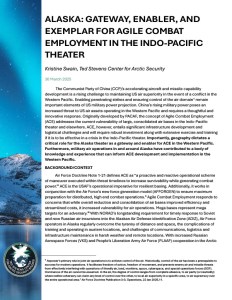The Communist Party of China (CCP)’s accelerating aircraft and missile capability development is a rising challenge to maintaining US air superiority in the event of a conflict in the Western Pacific. Enabling penetrating strikes and ensuring control of the air domain1 remain important elements of US military power projection. China’s rising military power poses an increased threat to US air assets operating in the Western Pacific and requires a thoughtful and innovative response. Originally developed by PACAF, the concept of Agile Combat Employment (ACE) addresses the current vulnerability of large, consolidated air bases in the Indo-Pacific theater and elsewhere. ACE, however, entails significant infrastructure development and logistical challenges and will require robust investment along with extensive exercise and training if it is to be effective in a crisis in the Indo-Pacific theater. Importantly, geography dictates a critical role for the Alaska theater as a gateway and enabler for ACE in the Western Pacific. Furthermore, military air operations in and around Alaska have contributed to a body of knowledge and experience that can inform ACE development and implementation in the Western Pacific.

